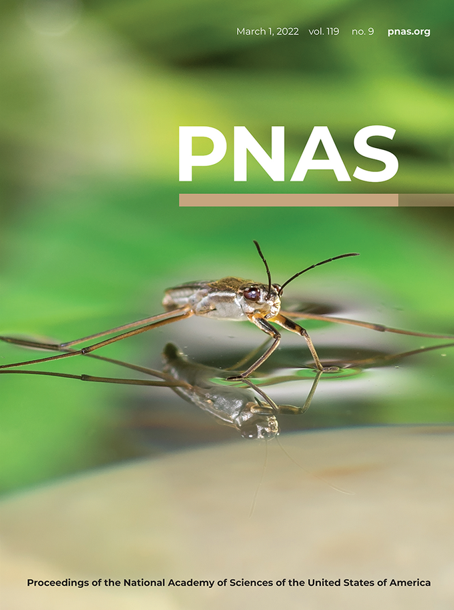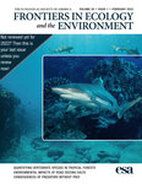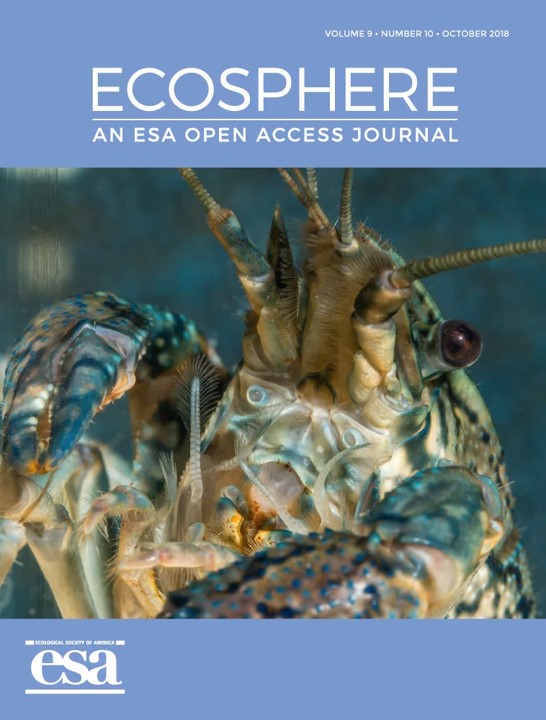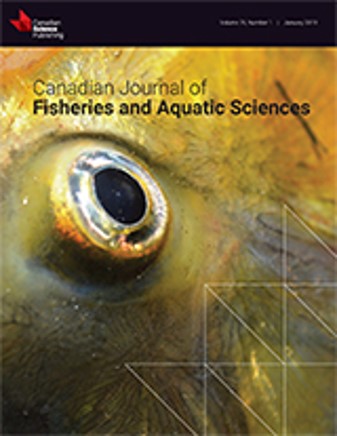|
Publications
52. Hintz, W. D., A. P. Porreca, and J. E. Garvey. 2024. Water velocity shapes fish movement behavior. Journal of Fish Biology __:__−__. 51. Kaushal, S. S., P. M. Mayer, R. R. Shatkay, C. M. Maas, M. Cañedo-Argüelles, W. D. Hintz, B. M. Wessel, K. Tully, M. A. Rippy, and S. B Grant. 2024. Salinization of Inland Waters. Treatise on Geochemistry, 3rd ed. 50. Borrelli, J., M. S. Schuler, W. D. Hintz, B. Mattes, C. Schermerhorn, E. Yates, L. W. Eichler, M. A. Lucius, L. Ahrens, and R. A. Relyea. 2024. Putting a lake together: Integrating synthetic data and field observations to build a better food web. Aquatic Sciences __:__-__. 49. Solomon, C. T., H. Dugan, W. D. Hintz, S. E. Jones. 2023. Upper limits for road salt pollution in lakes. Limnology and Oceanography Letters __:__−__. 48. E. Huber, B. Wilmoth, L. L. Hintz, A. D. Horvath, J. R. McKenna, and W. D. Hintz. 2023. Freshwater salinization reduces vertical movement rate and abundance of zooplankton: Interactions with predatory stress. Environmental Pollution 330: 121767. 47. Woodley, A., L. L. Hintz, B. Wilmoth, and W. D. Hintz. 2023. Impacts of water hardness and road deicing salts on zooplankton survival and reproduction. Scientific Reports 13:1-9 46. Borrelli, J., M. S. Schuler, W. D. Hintz, M. Alldred, B. Mattes, C. Schermerhorn, E. Yates, L. W. Eichler, M. A. Lucius, and R. A. Relyea. 2023. Putting a lake together: Integrating synthetic data and field observations to build a better food web. Food Webs __:__-__. 45. Gouveia, A., S. Qian, C. Mayer, J. Smith, J. Bossenbroek, W. D. Hintz, R. Mapes, E. Weimer, J. Navarro, J. M. Dettmers, R. Young, J. T. Buszkiewicz, P. Kocovsky. 2023. A restructured Bayesian approach to estimate the abundance of a rare and invasive fish. Biological Invasions 25: 1711-1721. 44. Arnott, S. E., V. Fugère, C. C. Symons, S. J. Melles, B. E. Beisner, M. Cañedo-Argüelles, M.-P. Hébert, J. A. Brentrup, A. L. Downing, D. K. Gray, D. Greco, W. D. Hintz, A. McClymont, R. A. Relyea, J. A. Rusak, C. L. Searle, L. Astorg, H. K. Baker, Z. Ersoy, C. Espinosa, J. M. Franceschini, A. T. Giorgio, N. Göbeler, E. Hassal, M. Huynh, S. Hylander, K. L. Jonasen, A. Kirkwood, S. Langenheder, O. Langvall, H. Laudon, L. Lind, M. Lundgren, E. R. Moffett, L. Proia, M. S. Schuler, J. B. Shurin, C. F. Steiner, M. Striebel, S. Thibodeau, P. Urrutia Cordero, L. Vendrell-Puigmitja, G. A. Weyhenmeyer, A. M. Derry. 2023. Widespread variation in salt tolerance within freshwater zooplankton species reduces the predictability of community-level salt tolerance. Limnology and Oceanography Letters 8 (1), 8-18. 43. Hébert, M.P., C. Symons, M. C. Argüelles, S. E. Arnott, A. M. Derry, V. Fugère, W. D. Hintz, S. E. Arnott, D. Greco, A. McClymont, J. A. Brentrup, M. Cañedo-Argüelles, A. L. Downing, D. K. Gray, S. J. Melles, R. A. Relyea, J. A. Rusak, C. L. Searle, L. Astorg, H. K. Baker, K. L. Cottingham, Z. Ersoy, C. Espinosa, J. Franceschini, A. T. Giorgio, N. Göbeler, E. Hassal, M. Huynh, S. Hylander, K. L. Jonasen, A. E. Kirkwood, S. Langenheder, O. Langvall, H. Laudon, L. Lind, M. Lundgren, L. Proia, M. S. Schuler, J. B. Shurin, C. F. Steiner, M. Striebel, S. Thibodeau, P. Urrutia-Cordero, L. Vendrell-Puigmitj, G. A. Weyhenmeyer, and B. E. Beisner. 2023. Lake salinization drives consistent losses of zooplankton abundance and diversity across coordinated experiments. Limnology and Oceanography Letters 8 (1), 19-29. 42. Hintz, W. D., S. E. Arnott, C. C. Symon3, D. Greco, A. McClymont, J. A. Brentrup, M. Cañedo-Argüelles, A. M. Derry, A. L. Downing, D. K. Gray8, S. J. Melles, R. A. Relyea, J. A. Rusak, C. L. Searle, L. Astorg, H. K. Baker, B. E. Beisner, K. L. Cottingham, Z. Ersoy, C. Espinosa, J. Franceschini, A. T. Giorgio, N. Göbeler, E. Hassal, M.P. Hébert, M. Huynh, S. Hylander, K. L. Jonasen, A. E. Kirkwood, S. Langenheder, O. Langvall, H. Laudon, L. Lind, M. Lundgren, L. Proia, M. S. Schuler, J. B. Shurin, C. F. Steiner, M. Striebel, S. Thibodeau, P. Urrutia-Cordero, L. Vendrell-Puigmitj, G. A. Weyhenmeyer. 2022. Current water quality guidelines across North America and Europe do not protect lakes from salinization. Proceedings of the National Academy of Sciences 119 (9) e2115033119. 41. Hintz, W. D., L. Fay, and R. A. Relyea. 2022. Road salts, human safety, and the rising salinity of our fresh waters. Frontiers in Ecology and the Environment 20: 22-30. 40. Shane, K. D., M. Oubre, T. D. Crail, J. G. Miner, C. M. Mayer, T. E. Sasak, R. L. DeBruyne, J. J. Miller, E. F. Roseman, and W. D. Hintz. 2021. Towards improving an Area of Concern: Main-channel habitat rehabilitation priorities for the Maumee River. Journal of Great Lakes Research 47: 1429-1436. 39. Coldsnow, K. D., W. D. Hintz, M. S. Schuler, A. B. Stoler, and R. A. Relyea. 2021. Calcium chloride pollution mitigates the negative effects of an invasive clam. Biological Invasions 23: 1349-1366. 38. Hintz, W. D., M. S. Schuler, J. J. Borrelli, L. W. Eichler, A. B. Stoler, V. M. Moriarty, C. W. Boylen, S. A. Nierzwicki-Bauer, and R. A. Relyea. 2020. Concurrent improvement and deterioration of epilimnetic water quality in an oligotrophic lake over 37 years. Limnology and Oceanography 65: 927-938. 37. Schuler, M. S., W. D. Hintz, D. K. Jones, B. M. Mattes, A. B. Stoler, and R. A. Relyea. 2020. The effects of nutrient enrichment and invasive mollusks on freshwater environments. Ecosphere 11 (10), e03196. 36. Garcia-Quismondo Fernandez, M., W. D. Hintz, M. S. Schuler, and R. A. Relyea. 2020. Modeling diel vertical migration with membrane computing. Journal of Membrane Computing 10.1007/s41965-020-00038-y 35. Hintz, W. D., M. S. Schuler, D. K. Jones, K. D. Coldsnow, A. B. Stoler, and R. A. Relyea. 2019. Nutrients influence the multi-trophic impacts of an invasive species unaffected by native competitors or predators. Science of the Total Environment 694: 133704. 34. Hintz, W. D. and R. A. Relyea. 2019. A review of the species, community, and ecosystem impacts of road salt salinization in fresh waters. Freshwater Biology 64(6): 1081−1097. 33. Hintz, W. D., D. K. Jones, and R. A. Relyea. 2019. Evolved tolerance to freshwater salinization in zooplankton: Life history tradeoffs, cross-tolerance, and reducing cascading effects. Philosophical Transactions of the Royal Society B. 374: 20180012. 32. Schuler, M. S., M. Cañedo-Argüelles, W. D. Hintz, B. Dyack, S. Birk, and R. A. Relyea. 2019. Regulations are needed to protect freshwater ecosystems from salinization. Philosophical Transactions of the Royal Society B. 374: 20180019. 31. Hintz, W. D. and D. G. Lonzarich. 2018. Maximizing foraging success: the roles of group size, predation risk, competition, and ontogeny. Ecosphere 9 (10): e02456. 30. Lind, L., M. S. Schuler, W. D. Hintz, A. B. Stoler, D. K. Jones, B. M. Mattes, and R. A. Relyea. 2018. Salty fertile lakes: How salinization and eutrophication alter the structure of freshwater communities. Ecosphere 9 (9): e02383. 29. Jones, D. K., E. K. Yates, B. M. Mattes, W. D. Hintz, M.S. Schuler, and R. A. Relyea. 2018. Timing and frequency of sublethal exposure modifies the induction and retention of increased insecticide tolerance in wood frogs (Lithobates sylvaticus). Environmental Toxicology & Chemistry 37:2188-2197. 28. Hintz, W. D., B. M. Mattes, M. S. Schuler, D. K. Jones, A. B. Stoler, L. Lind, and R. A. Relyea. 2017. Salinization triggers a trophic cascade in experimental freshwater communities with varying food-chain length. Ecological Applications 27:833-844. 27. Hintz, W. D. and R. A. Relyea. 2017. A salty landscape of fear: Responses of fish and zooplankton to freshwater salinization and predatory stress. Oecologia 185:147-156. 26. Hintz, W. D. and R. A. Relyea. 2017. Impacts of road deicing salts on the early-life growth and development of a stream salmonid: Salt type matters. Environmental Pollution 223:409-415. 25. Jones, D. K., W. D. Hintz, M.S. Schuler, E. K. Yates, B. M. Mattes, and R. A. Relyea. 2017. Induced tolerance to agrochemicals was paved by evolutionary responses to predators. Environmental Science & Technology 51:13913-13919. 24. Porreca, A. P., W. D. Hintz, D. C. Coulter, and J. E. Garvey. 2017. Subtle physiological and morphological differences predict ecological success of sympatric congeners. Ecosphere 8:e01988. 23. Stoler, A. B., W. D. Hintz, D. K. Jones, L. Lind, M. S. Schuler, and R. A. Relyea. 2017. Leaf litter mediates the impact of road salt on forested wetland communities. Freshwater Science 36:415-426. 22. Schuler, M. S., W. D. Hintz, D. K. Jones, L. Lind, B. M. Mattes, A. B. Stoler, K. Sudol, and R. A. Relyea. 2017. How common road salts and organic additives alter freshwater food webs: in search of safer alternatives. Journal of Applied Ecology 54:1353-1361. 21. Hintz, W. D., D. C. Glover, B. C. Szynkowski, and J. E. Garvey. 2017. Spatiotemporal reproduction and larval habitat associations of non-native silver carp and bighead carp. Transactions of the American Fisheries Society 146:422-431. 20. Stoler, A. B., B. M. Mattes, W. D. Hintz, D. K. Jones, L. Lind, M. S. Schuler, and R. A. Relyea. 2017. Leaf litter quality alters effects of a common pesticide on wetland communities. Environmental Pollution 226:452-462. 19. Porreca, A. P., W. D. Hintz, and J. E. Garvey. 2017. Do alluvial sand dunes generate energetic refugia for benthic fishes? An experimental test with the endangered pallid sturgeon. River Research and Applications 33:690-696. 18. Rude, N. P., D. C. Glover, W. D. Hintz, S. C. Hirst, W. E. Herndon, R. B. Hilsabeck, and G. W. Whitledge. 2017. Long-term mark-recapture data to assess Muskellunge population characteristics: application to two Illinois reservoirs. American Fisheries Society Special Publication. 17. Coldsnow, K. D., B. M. Mattes, W. D. Hintz, and R. A. Relyea. 2017. Rapid evolution of tolerance to road salt in zooplankton. Environmental Pollution 222:367-373. 16. Stoler, A. B., B. M. Walker, W. D. Hintz, D. K. Jones, L. Lind, M. S. Schuler, and R. A. Relyea. 2017. Combined effects of road salt and an insecticide on wetland communities. Environmental Toxicology and Chemistry 36:771-779. 15. Hintz, W. D., N. K. MacVey, A. P. Porreca, A. M. Asher, and J. E. Garvey. 2017. Variation in prey selection and foraging success associated with early−life ontogeny and habitat use of American paddlefish (Polyodon spathula). Ecology of Freshwater Fish 26:181-189. 14. Jones, D. K., B. M. Mattes, W. D. Hintz, M.S. Schuler, A. B. Stoler, L. Lind, R. Cooper, and R. A. Relyea. 2017. Investigation of road salts and biotic stressors on wetland communities. Environmental Pollution 221:159-167. 13. Porreca, A. P., W. D. Hintz, G. W. Whitledge, N. P. Rude, E. J. Heist. and J. E. Garvey. 2016. Establishing ecologically relevant management boundaries: Linking movement ecology with the conservation of Scaphirhynchus sturgeon. Canadian Journal of Fisheries and Aquatic Sciences 73:877-884. 12. Hintz, W. D., G. G. Grimes, and J. E. Garvey. 2016. Scaling down habitat selection by large river fishes to understand patterns relevant to individuals. River Research and Applications 32: 689-696. 11. Hintz, W. D., D. C. Glover, J. E. Garvey, K. J. Killgore, D. P. Herzog, T. W. Spier, R. E. Colombo, and R. A. Hrabik. 2016. Status and habitat use of Scaphirhynchus sturgeons in an important fluvial corridor: Implications for river habitat enhancement. Transactions of the American Fisheries Society 145: 386-399. 10. Hintz, W. D., A. P. Porreca, J. E. Garvey, Q. E. Phelps , S. J. Tripp, R. A. Hrabik, and D. P. Herzog. 2015. Abiotic attributes surrounding alluvial islands generate critical fish habitat. River Research and Applications 31: 1218–1226. 9. Johnson, J. L., W. D. Hintz, J. E. Garvey, Q. E. Phelps, and S. J. Tripp. 2014. Evaluating growth, survival and swimming performance to determine the feasibility of telemetry for age-0 pallid sturgeon (Scaphirhynchus albus). The American Midland Naturalist 171: 68–77. 8. Hintz, W. D. and T. Wellnitz. 2013. Current velocity influences the facilitation and removal of algae by stream grazers. Aquatic Ecology 47: 235–244. 7. Rude, N. P., W. D. Hintz, J. D. Norman, K. L. Kanczuzewski, A. J. Yung, K. D. Hofer, and G. W. Whitledge. 2013. Using pectoral fin rays as a non-lethal aging structure for smallmouth bass: precision with otolith age estimates and the importance of reader experience. Journal of Freshwater Ecology 28: 199–210. 6. Hintz, W. D., G. G. Grimes, and J. E. Garvey. 2013. Shovelnose sturgeon exhibit predator avoidance behavior in the presence of a hungry predator. Journal of Applied Ichthyology 29: 2–5. 5. Hintz, W. D. and J. E. Garvey. 2012. Considering a species-loss domino-effect before endangered species legislation and protected area implementation. Biodiversity and Conservation 21: 2017–2027. 4. Hintz, W. D. and D. G. Lonzarich. 2012. Emergence timing and subsequent downstream movements of two non-native salmonids in a Lake Superior tributary. Journal of Great Lakes Research 38: 309–316. 3. Hintz, W. D. 2011. Reconnecting floodplains. Frontiers in Ecology and the Environment 9: 431–431. 2. Merten, E. C., W. D. Hintz, A. F. Lightbody, and T. Wellnitz. 2010. Macroinvertebrate grazers, current velocity, and bedload influence periphytic accrual in a field-scale experimental stream. Hydrobiologia 652: 179–184. 1. Phelps, Q. E., S. J. Tripp, W. D. Hintz, J. E. Garvey, D. P. Herzog, D. E. Ostendorf, J. W. Ridings, J. W. Crites, and R. A. Hrabik. 2010. Water temperature and river stage influence mortality and abundance of naturally occurring Mississippi River Scaphirhynchus sturgeon. North American Journal of Fisheries Management 30: 767–775. |















